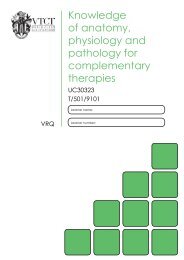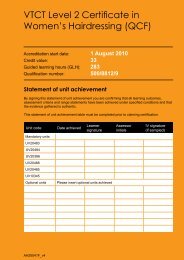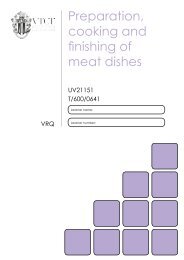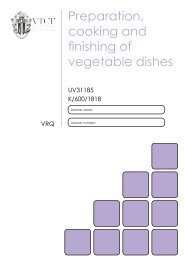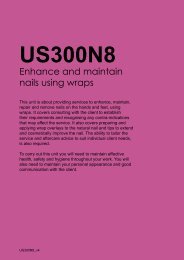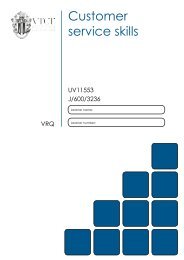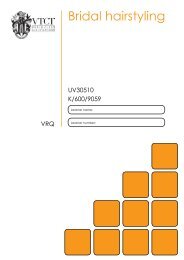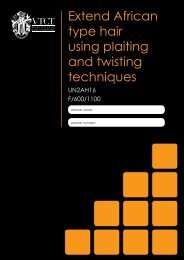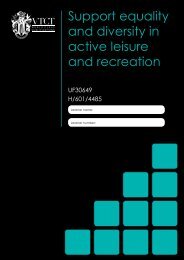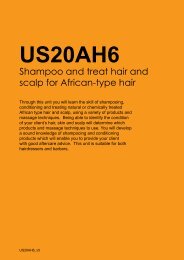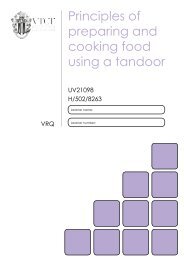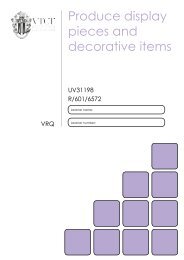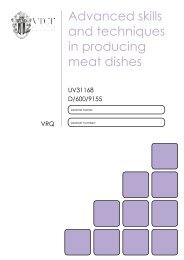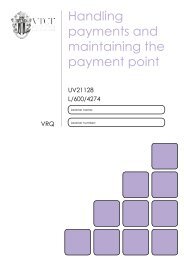Remove hair using waxing techniques - VTCT
Remove hair using waxing techniques - VTCT
Remove hair using waxing techniques - VTCT
You also want an ePaper? Increase the reach of your titles
YUMPU automatically turns print PDFs into web optimized ePapers that Google loves.
VRQ<br />
<strong>Remove</strong> <strong>hair</strong><br />
<strong>using</strong> <strong>waxing</strong><br />
<strong>techniques</strong><br />
UV20418<br />
J/601/3555<br />
Learner name:<br />
Learner number:
Statement of unit achievement<br />
<strong>VTCT</strong> is the specialist awarding body for the Hairdressing, Beauty Therapy,<br />
Complementary Therapy and Sport and Active Leisure sectors, with over 45<br />
years of experience.<br />
<strong>VTCT</strong> is an awarding body regulated by national organisations including<br />
Ofqual, SQA, DCELLS and CCEA.<br />
<strong>VTCT</strong> is a registered charity investing in education and skills but also giving to<br />
good causes in the area of facial disfigurement.<br />
By signing this statement of unit achievement you are confirming that all learning outcomes, assessment<br />
criteria and range statements have been achieved under specified conditions and that the evidence<br />
gathered is authentic.<br />
This statement of unit achievement table must be completed prior to claiming certification.<br />
Unit code Date achieved Learner signature<br />
Assessor tracking table<br />
Assessor name Assessor signature<br />
Assessor<br />
initials<br />
Assessors<br />
initials<br />
IV signature<br />
(if sampled)<br />
All assessors <strong>using</strong> this Record of Assessment book must complete this table. This is required for<br />
verification purposes.<br />
Assessor number<br />
(optional)
UV20418<br />
<strong>Remove</strong> <strong>hair</strong> <strong>using</strong> <strong>waxing</strong><br />
<strong>techniques</strong><br />
This unit is about removing <strong>hair</strong> <strong>using</strong> <strong>waxing</strong> <strong>techniques</strong>.<br />
The areas to be treated include the eyebrows, face, legs,<br />
underarm, and bikini line. You will need to be able to<br />
consult with the client, and prepare and plan the treatment.<br />
You will also need to provide aftercare advice, including the<br />
avoidance of certain activities and the use of home care<br />
products.<br />
UV20418_v7
Level<br />
Credit value<br />
GLH<br />
2<br />
6<br />
57<br />
Observation(s)<br />
4<br />
External paper(s)<br />
1
<strong>Remove</strong> <strong>hair</strong> <strong>using</strong> <strong>waxing</strong><br />
<strong>techniques</strong><br />
Learning outcomes Evidence requirements<br />
On completion of this unit you will:<br />
1. Be able to prepare for <strong>waxing</strong> treatments<br />
2. Be able to provide <strong>waxing</strong> treatments<br />
1. Environment<br />
Evidence for this unit must be gathered in a<br />
real or realistic working environment.<br />
2. Simulation<br />
Simulation is not allowed in this unit.<br />
3. Observation outcomes<br />
Competent performance of ‘Observation’<br />
outcomes must be demonstrated to your<br />
assessor on at least four occasions.<br />
4. Range<br />
All ranges must be practically demonstrated<br />
or other forms of evidence produced to<br />
show they have been covered.<br />
5. Knowledge outcomes<br />
There must be evidence that you possess<br />
all the knowledge and understanding<br />
listed in the ‘Knowledge’ section of this<br />
unit. This evidence may include projects,<br />
assignments, case studies, reflective<br />
accounts, oral/written questioning and/or<br />
other forms of evidence.<br />
6. Tutor/Assessor guidance<br />
You will be guided by your tutor/assessor<br />
on how to achieve learning outcomes and<br />
ranges in this unit. All outcomes and ranges<br />
must be achieved.<br />
7. External paper<br />
Knowledge and understanding in this unit<br />
will be assessed by an external paper.<br />
The criteria that make up this paper are<br />
highlighted in white throughout this unit.<br />
There is one external paper that must be<br />
achieved.<br />
UV20418<br />
3
4<br />
Achieving observations<br />
and range<br />
Achieving observation outcomes<br />
Your assessor will observe your performance<br />
of practical tasks. The minimum number<br />
of observations required is indicated in the<br />
evidence requirements section of this unit.<br />
Criteria may not always naturally occur during<br />
a practical observation. In such instances you<br />
will be asked questions to demonstrate your<br />
competence in this area. Your assessor will<br />
document the criteria that have been achieved<br />
through oral questioning.<br />
Your assessor will sign off an outcome when all<br />
criteria have been competently achieved in a<br />
single client service.<br />
Achieving range<br />
The range section indicates what must<br />
be covered. Ranges should be practically<br />
demonstrated as part of an observation. Where<br />
this is not possible other forms of evidence may<br />
be produced. All ranges must be covered.<br />
Your assessor will document the portfolio<br />
reference once a range has been competently<br />
achieved.<br />
UV20418<br />
Maximum service times<br />
The following maximum service times apply to<br />
this unit:<br />
Eyebrow wax 15 minutes<br />
Underarm wax 15 minutes<br />
Half leg wax 30 minutes<br />
Bikini line wax 15 minutes<br />
Full leg wax 45 minutes<br />
Upper lip wax 10 minutes<br />
Chin wax 10 minutes
Outcome 1<br />
Be able to prepare for <strong>waxing</strong> treatments<br />
You can:<br />
a. Prepare yourself, client and work area for a<br />
<strong>waxing</strong> treatment<br />
b. Use suitable consultation <strong>techniques</strong> to<br />
identify treatment objectives<br />
c. Carry out necessary tests prior to the<br />
treatment<br />
d. Provide clear recommendations to the client<br />
e. Select products, tools and equipment to suit<br />
client treatment needs<br />
*May be assessed through oral questioning.<br />
Observations<br />
Observation 1 2 3 4<br />
Date achieved<br />
Criteria questioned orally<br />
Portfolio reference<br />
Assessor initials<br />
Learner signature<br />
UV20418 5
6<br />
© Habia<br />
Outcome 2<br />
Be able to provide <strong>waxing</strong> treatments<br />
You can:<br />
a. Communicate and behave in a professional<br />
manner<br />
b. Follow health and safety working practices<br />
and industry Code of Practice for Waxing<br />
Services<br />
c. Position yourself and the client correctly<br />
throughout the treatment<br />
d. Use products, tools, equipment and<br />
<strong>techniques</strong> to suit client’s treatment needs,<br />
skin type and conditions<br />
e. Complete the treatment to the satisfaction<br />
of the client<br />
f. Record the results of the treatment<br />
g. Provide suitable aftercare advice<br />
*May be assessed through oral questioning.<br />
Observation<br />
Date achieved<br />
Criteria questioned orally<br />
Portfolio reference<br />
Assessor initials<br />
Learner signature<br />
1 2 3 4<br />
UV20418
*You must practically demonstrate that you have:<br />
Range<br />
Used all consultation <strong>techniques</strong> Portfolio reference<br />
Questioning<br />
Visual<br />
Manual<br />
Reference to client records<br />
Carried out all <strong>waxing</strong> treatments Portfolio reference<br />
Eyebrows<br />
Upper lip<br />
Chin<br />
Full leg<br />
Half leg<br />
Underarm<br />
Bikini line<br />
Dealt with a minimum of 1 necessary action Portfolio reference<br />
Encouraging the client to seek medical advice<br />
Explaining why the <strong>waxing</strong> service cannot be carried out<br />
Modification of the <strong>waxing</strong> service<br />
Used all types of <strong>waxing</strong> products on the appropriate part of the<br />
body<br />
Hot wax<br />
Warm wax<br />
Portfolio reference<br />
*It is strongly recommended that all range items are practically demonstrated. Where this is not<br />
possible, other forms of evidence may be produced to demonstrate competence.<br />
UV20418 7
8<br />
© Habia<br />
*You must practically demonstrate that you have:<br />
Used all work <strong>techniques</strong> Portfolio reference<br />
Stretching and manipulating the skin during application and removal<br />
Speed of product removal<br />
Direction and angle of removal<br />
On-going product temperature checks<br />
Provided all types of advice Portfolio reference<br />
Avoidance of activities which may cause contra-actions<br />
Suitable home care products and their use<br />
Recommended time intervals in between <strong>waxing</strong> treatments<br />
*It is strongly recommended that all range items are practically demonstrated. Where this is not<br />
possible, other forms of evidence may be produced to demonstrate competence.<br />
UV20418
Achieving knowledge outcomes<br />
You will be guided by your tutor and assessor<br />
on the evidence that needs to be produced.<br />
Your knowledge and understanding will be<br />
assessed <strong>using</strong> the assessment methods listed<br />
below:<br />
• Observed work<br />
• Witness statements<br />
• Audio-visual media<br />
• Evidence of prior learning or attainment<br />
• Written questions<br />
• Oral questions<br />
• Assignments<br />
• Case studies<br />
Achieving the external paper<br />
Developing knowledge<br />
Where possible your assessor will integrate<br />
knowledge outcomes into practical observations<br />
through oral questioning.<br />
The external paper will test your knowledge of the criteria highlighted in white. A pass mark of<br />
70% must be achieved. Criteria not achieved will be identified to your tutor/assessor. You will then<br />
be orally questioned or asked to produce other forms of evidence as all unit criteria must<br />
be achieved.<br />
Your assessor will complete the following table when the 70% pass mark has been achieved.<br />
Paper Date achieved Assessor initials<br />
1 of 1<br />
© Habia<br />
UV20418 9
10<br />
Knowledge<br />
Outcome 1<br />
Be able to prepare for <strong>waxing</strong> treatments<br />
You can:<br />
f. Describe salon requirements for preparing yourself, the client and<br />
work area<br />
g. State the environmental conditions suitable for <strong>waxing</strong> treatments<br />
h. Describe different consultation <strong>techniques</strong> used to identify<br />
treatment objectives<br />
i. Describe the types of tests that are carried out prior to <strong>waxing</strong><br />
treatment<br />
j. Describe how to select products, tools and equipment to suit client<br />
treatment needs<br />
k. Identify the different types of <strong>waxing</strong> methods and products<br />
available<br />
l. State the advantages and disadvantages of alternative methods of<br />
<strong>hair</strong> removal<br />
m. Describe the effects alternative methods of <strong>hair</strong> removal may have<br />
on the skin and <strong>waxing</strong> treatments<br />
n. Describe the contra-indications which prevent or restrict <strong>waxing</strong><br />
treatments<br />
*Assessor initials to be inserted if orally questioned.<br />
Requirements highlighted in white are assessed in the external paper.<br />
UV20418<br />
Portfolio reference/<br />
Assessor initials*
Outcome 2<br />
Be able to provide <strong>waxing</strong> treatments<br />
You can:<br />
h. State how to communicate and behave in a professional manner<br />
i. Describe health and safety working practices and industry Code of<br />
Practice for Waxing Services<br />
j. State the importance of positioning yourself and the client correctly<br />
throughout the treatment<br />
k. State the importance of <strong>using</strong> products, tools, equipment and<br />
<strong>techniques</strong> to suit client’s treatment needs<br />
l. Describe how treatments can be adapted to suit client treatment<br />
needs, skin types and conditions<br />
m. State the contra-actions that may occur during and following<br />
treatments and how to respond<br />
n. State the importance of completing the treatment to the satisfaction<br />
of the client<br />
o. State the importance of completing treatment records<br />
p. State the aftercare advice that should be provided<br />
q. Describe the structure and functions of the skin<br />
r. Describe diseases and disorders of the skin<br />
*Assessor initials to be inserted if orally questioned.<br />
Requirements highlighted in white are assessed in the external paper.<br />
Portfolio reference/<br />
Assessor initials*<br />
© Habia<br />
UV20418 11
12<br />
Unit content<br />
This section provides guidance on the recommended knowledge and skills required to enable you<br />
to achieve each of the learning outcomes in this unit. Your tutor/assessor will ensure you have the<br />
opportunity to cover all of the unit content.<br />
Outcome 1: Be able to prepare for <strong>waxing</strong> treatments<br />
Management of health and safety at<br />
work: Clean up spillages, report slippery<br />
surfaces, remove report obstacles, good<br />
all round access to trolleys and equipment,<br />
sterilise or disinfect tools, equipment, work<br />
surfaces, personal protective equipment.<br />
Electricity at work – checking/visual<br />
check of equipment, no trailing wires<br />
portable appliance testing.<br />
Manual handling – moving stock, lifting,<br />
working heights, unpacking, posture,<br />
deportment, balance weight, preserve<br />
back, prevent slouching.<br />
Towels – clean for every client, dirty towels<br />
in covered bin.<br />
Liability insurance – employers, public,<br />
professional indemnity.<br />
Reporting of injuries, diseases and<br />
dangerous occurrences – accident book,<br />
reporting diseases, local byelaws, code of<br />
conduct, risk assessment.<br />
Control of substances hazardous<br />
to health – replace lids, ventilation for<br />
vapour and dust, avoid over exposure<br />
to chemicals, correct use of chemicals,<br />
follow storage handling use and disposal,<br />
correct disposal of contaminated waste,<br />
products, check end date, packaging,<br />
store away from heat, damp and direct<br />
sunlight, dispose of contaminated waste in<br />
a closed top bin, relevant manufacturer’s<br />
instructions, no smoking, eating or drinking.<br />
Health and safety legislation: Data<br />
protection, electricity at work, employer’s<br />
liability (compulsory insurance), fire<br />
UV20418<br />
precautions, first aid at work, health<br />
and safety at work, local government<br />
miscellaneous provisions, occupier’s<br />
liability, local byelaws.<br />
Regulations: Control of substances<br />
hazardous to health, management<br />
of health and safety at work, manual<br />
handling, personal protective equipment,<br />
reporting of injuries, diseases and<br />
dangerous occurrences, workplace (health<br />
and welfare).<br />
Hazards and risks: A hazard is something<br />
that has the potential to cause harm. A risk<br />
is the likelihood of a hazard happening.<br />
Employer responsibility: Current and<br />
valid liability insurance, display health and<br />
safety rules (covering staff, employees,<br />
clients), fire evacuation, provide regular<br />
training, accurate record keeping,<br />
monitoring.<br />
Hazards: Something with potential<br />
to cause harm, requiring immediate<br />
legislation, level of responsibility, report,<br />
nominated personnel, duty to recognise/<br />
deal with hazards.<br />
Equipment: Only used for intended<br />
purpose, safe usage, handling, storage,<br />
cleaning, lifting, visual checks, worn, faulty,<br />
repairs, maintenance, portable appliance<br />
testing, correct disposal of contaminated<br />
waste, records.<br />
Security (cash): Staff training, point of<br />
sale, regular banking, in transit.<br />
Security (people): Staff, clients, visitors,<br />
children, personal belongings, systems
Outcome 1: Be able to prepare for <strong>waxing</strong> treatments (continued)<br />
(security, emergency evacuation, storage,<br />
client records, business information).<br />
Risk: Likelihood of a hazard happening,<br />
risk assessment, determine the level of<br />
risk, preventative measures, reduce a<br />
potentially harmful situation, judgement<br />
of salon hazards, who, what, level of<br />
risk, interpret results, conclusions, record<br />
findings, regular reviews.<br />
Reasons for risk assessment: Staff,<br />
visitor, client health and safety, safe<br />
environment, minimising hazards and risks,<br />
requirement of legislation.<br />
Hygiene:<br />
General – sterilise and sanitise tools,<br />
disinfect work surfaces, cover cuts and<br />
abrasions, sanitise therapist’s hands before<br />
and after treatments, sanitise with sprays<br />
and gels, clean towels between client, dirty<br />
towels in covered bin, disposable towels,<br />
dispense products with a spatula, pump or<br />
spray, disposables used wherever possible,<br />
no smoking, personal hygiene, replace<br />
loose lids, uncapped bottles and pots.<br />
Sterilisation – (tweezers/scissors)<br />
autoclave, glass bead, chemical, UV<br />
cabinet for storage only.<br />
Disinfection – heat or chemical methods,<br />
bactericides, fungicides, viricides, UV<br />
cabinet for storage only.<br />
Disposal of waste: Single use items,<br />
pedal bin with a liner, spillages and unused<br />
chemicals, contaminated waste, hazardous<br />
waste, environmental protection.<br />
Therapist posture and deportment:<br />
Correct posture when sitting, correct<br />
posture when lifting, correct posture<br />
when carrying, working methods to<br />
avoid Repetitive Strain Injury (RSI), hand<br />
© Habia<br />
exercises, standing posture, even weight<br />
distribution, client comfort, maintain<br />
modesty, client correctly positioned to get<br />
maximum benefit from treatment, ensure<br />
therapist positioning delivers appropriate<br />
<strong>techniques</strong>, appropriate space between<br />
client and therapist, prevent injury, optimum<br />
results, allow for visual checks.<br />
Work area: clean and hygienic, height<br />
adjustable c<strong>hair</strong>, correct posture, correct<br />
couch height, lighting, ventilation, noise,<br />
music, temperature, ambience, no trailing<br />
wires, no obstructions, tools and equipment<br />
in a safe working position for therapist.<br />
Client preparation: Protect client clothing,<br />
client comfort, privacy, modesty, client<br />
positioned correctly.<br />
Communication:<br />
Verbal – speaking manner and tone,<br />
professional, supportive, respectful,<br />
sensitive to client, open questioning related<br />
to treatment.<br />
Non-verbal – eye contact, body language,<br />
listening.<br />
Record keeping: Accurate appointment<br />
systems, stationery, loyalty, rewards,<br />
acknowledgement of occasions,<br />
consultation record keeping, signatures,<br />
refer to existing records, information clear<br />
and accurate, logical order, name, address,<br />
contact numbers, age range, reason for<br />
treatment, occupation, sport/hobbies,<br />
medical history, allergies/hypersensitivity,<br />
contact lenses, contra-actions,<br />
contra-indications, skin sensitivity<br />
tests, adaptations and modifications,<br />
recommendations, requirement, treatment<br />
plan, update record at the end of the<br />
treatment, update at each visit, records<br />
maintained electronically, paper records.<br />
UV20418 13
14<br />
© Habia<br />
Outcome 1: Be able to prepare for <strong>waxing</strong> treatments (continued)<br />
Professional appearance: Clean<br />
professional uniform, no jewellery, <strong>hair</strong><br />
neatly tied back, fringe secured, closed in<br />
footwear, make-up (light day make-up),<br />
personal hygiene and cleanliness (shower<br />
bath), cover cuts and abrasions, deodorant<br />
or antiperspirant, oral hygiene, clean teeth,<br />
fresh breath, nails (good condition and<br />
maintained), no piercings.<br />
Professional ethical conduct: Polite,<br />
cheerful and friendly manner, friendly facial<br />
expressions, positive attitude, eye contact,<br />
open body language, client relations,<br />
confidentiality, respect for colleagues and<br />
competitors, avoid gossip, pride in work,<br />
punctuality, employer and client loyalty.<br />
Consultation <strong>techniques</strong>: Client<br />
requirements, client satisfaction, client<br />
expectations and aftercare, signatures,<br />
visual, manual, listen, client card reference.<br />
Treatment objectives: Client needs<br />
and suitability, client agreement, realistic<br />
outcome, cost, duration and frequency of<br />
treatments, further treatments.<br />
Recommendations to client: Treatment<br />
process, expected sensations/skin<br />
reaction, outcomes, further treatments.<br />
Aftercare advice:<br />
Avoidance of activities that will cause<br />
contra-actions – exercise, swimming, heat<br />
treatments, other treatments, UV rays – for<br />
24 hours, avoid perfumed and chemical<br />
based products, self tan, restrictive<br />
clothing, avoidance of touching area.<br />
Home care advice – products suitable for<br />
home care, such as exfoliators to assist<br />
with in-growing <strong>hair</strong>s, skincare products. All<br />
aftercare and home care advice should be<br />
documented on record card.<br />
UV20418<br />
Skin sensitivity tests: Sugaring products<br />
24-48 hours before treatment, record<br />
results of patch test, client signature and<br />
date.<br />
Interpret results of skin sensitivity test:<br />
Positive – red, itchy, irritated, swelling.<br />
Negative – no change to skin.<br />
Patch test <strong>techniques</strong>: Cleanse area (for<br />
example either wrist or ankle), apply and<br />
remove each <strong>waxing</strong> product to the area,<br />
leave for a minimum of 24 hours, explain<br />
positive and negative reaction, if positive<br />
reaction experienced record products used<br />
and where on the body they were placed<br />
on record card, with date, and advise that<br />
treatment cannot be carried out.<br />
Importance of patch test: To prevent<br />
allergic reaction, invalidation of insurance<br />
policy if not carried out, always follow<br />
manufacturer’s instructions.
Outcome 2: Be able to provide <strong>waxing</strong> treatments<br />
Products: Skin sanitiser, skin cleanser<br />
(pre-wax lotion), after wax lotion, powder,<br />
hot wax, warm wax, barrier cream<br />
(petroleum jelly), wax pot cleaner.<br />
Tools: Spatula, orange stick, tweezers,<br />
wax strips, scissors (for trimming), eyebrow<br />
brush.<br />
Equipment: Large towel to protect client,<br />
couch, stool or c<strong>hair</strong>, trolley, bin with clinical<br />
waste liner, cotton wool, bowl, mirror,<br />
tissues, couch roll, wax heater, disposable<br />
gloves, apron.<br />
Selection process: Choice based on<br />
<strong>hair</strong> type, target areas of treatment, client<br />
preference, hot wax most suitable for<br />
strong <strong>hair</strong> growth, warm wax suitable for<br />
all areas.<br />
Temperature test: Test on self (on wrist<br />
to check heat), use spatula, remove with<br />
strip, test on small area of client to check<br />
comfortable working temperature prior<br />
to starting treatment, check temperature<br />
throughout treatment.<br />
Warm wax:<br />
Ingredients – formulation of glucose syrup<br />
(or fructose syrup), zinc oxide.<br />
Treatment technique – trim <strong>hair</strong>s where<br />
necessary, working temperature 43˚C,<br />
cleanse area, applied with spatula (no<br />
re-dipping, each spatula inserted into wax<br />
pot only once), spatula 45˚ angle, with<br />
the direction of <strong>hair</strong> growth, strips applied,<br />
removed against growth, apply soothing<br />
lotion to area, on-going temperature<br />
checks.<br />
Hot wax:<br />
Ingredients – formulation of beeswax,<br />
azulene, vitamin E.<br />
© Habia<br />
Treatment technique – working<br />
temperature 50˚C, area cleansed and<br />
dried, talc applied to lift <strong>hair</strong>s against<br />
growth, applied in small sections, <strong>waxing</strong><br />
with spatula against the <strong>hair</strong> growth, allow<br />
to set, flicking up the edge of wax, removal<br />
from flicked up edge against growth,<br />
support skin when removing and flicking up<br />
edge, regularly check temperature of wax<br />
whilst working.<br />
Tweezers: Sterilised, used to remove<br />
any stray <strong>hair</strong>s after treatment, dispose in<br />
clinical waste bin.<br />
Working methods – general: Stretch<br />
and manipulate the skin during application<br />
and removal, speed of removal, direction<br />
and angle of removal, on-going product<br />
temperature checks.<br />
Equipment: Checked for damage, dials,<br />
leads and plugs checked (no trailing<br />
wires), check with client throughout for<br />
comfort and sensitivity, always follow<br />
manufacturers’ instructions.<br />
Environmental conditions: Heating<br />
(warm), lighting (soft), noise level and<br />
music selection (relaxing/calming),<br />
ventilation (pleasant aroma), privacy of<br />
work area, client comfort, health, safety<br />
and hygiene requirements maintained<br />
throughout treatment.<br />
Examples of contra-indications that<br />
may prevent treatment: Contagious<br />
skin diseases, severe skin conditions,<br />
severe varicose veins, thin or fragile skin,<br />
scar tissue under 6 months old, certain<br />
medication (e.g. steroids), heat rash,<br />
sunburn, known allergies to products.<br />
Examples of contra-indications that<br />
may restrict treatment: Diabetes,<br />
moles, infected ingrowing <strong>hair</strong>s, skin tags,<br />
UV20418 15
16<br />
© Habia<br />
Outcome 2: Be able to provide <strong>waxing</strong> treatments (continued)<br />
medication, self tan products.<br />
Alternative methods of <strong>hair</strong> removal:<br />
Depilatory creams, threading, shaving,<br />
abrasive mitts, electrical razors/shavers.<br />
Depilatory creams:<br />
Advantages – no pain, economical, can be<br />
carried out at home, no skill required.<br />
Disadvantages – short term solution,<br />
messy, not suitable for all skin types.<br />
Plucking:<br />
Advantages – quick, economical, <strong>hair</strong>s<br />
grow back with tapered end.<br />
Disadvantages – only suitable for small<br />
areas.<br />
Threading:<br />
Advantages – quick, economical, small<br />
amount of equipment.<br />
Disadvantages – technique more difficult,<br />
can break <strong>hair</strong>, suitable for small areas.<br />
Shaving:<br />
Advantages – quick, can be done at<br />
home, no pain, no skill required.<br />
Disadvantages – short term, quick<br />
regrowth, bristly re-growth.<br />
Abrasive mitts:<br />
Advantages – exfoliates, quick,<br />
economical, no skill required.<br />
Disadvantages – <strong>hair</strong> can break, regrowth<br />
quick, not good for strong <strong>hair</strong> growth.<br />
Electrical appliances:<br />
Advantages – quick, can be done at<br />
home, reusable, no skills.<br />
Disadvantages – quick regrowth, bristly<br />
regrowth.<br />
UV20418<br />
Effects on skin: Some methods are not<br />
suitable for sensitive skin (hot, depilatory<br />
creams, abrasive mitts), <strong>waxing</strong> will remove<br />
dead skin cells (abrasive mitts, hot, warm),<br />
skin can be damaged by some methods<br />
of <strong>waxing</strong> (hot, warm, depilatory creams,<br />
abrasive mitts).<br />
Effects on <strong>hair</strong> growth:<br />
In-growing <strong>hair</strong>s – warm, hot.<br />
Hair breakage – threading, plucking,<br />
abrasive mitts.<br />
Quick <strong>hair</strong> regrowth – shaving, abrasive<br />
mitts, depilatory creams, electrical<br />
appliances.<br />
Possible contra-actions:<br />
Excessive erythema – apply cold<br />
compress, if persists seek medical advice.<br />
Allergic reaction – remove product<br />
immediately, apply cold compress, if<br />
persists seek medical advice.<br />
In-growing <strong>hair</strong>s – avoid restrictive<br />
clothing, exfoliate regularly.<br />
Burns – apply cold compress, seek<br />
medical advice if necessary.<br />
Skin removal – apply cold compress, seek<br />
medical advice if necessary.<br />
Normal reaction – erythema, light blood<br />
spots, slight raised bumps/rash.<br />
Skin:<br />
Epidermis – basal cell layer (stratum<br />
germinativum), prickle cell layer (stratum<br />
spinosum), granular layer (stratum<br />
granulosum), clear layer (stratum lucidum),<br />
horny layer (stratum corneum).<br />
Dermis – blood and lymph supply,<br />
fibroblasts – collagen, elastin, <strong>hair</strong>,
Outcome 2: Be able to provide <strong>waxing</strong> treatments (continued)<br />
sebaceous glands, arrector pili muscle,<br />
dermal papilla, sweat glands (eccrine and<br />
apocrine), sensory nerve endings.<br />
Hypodermis – subcutaneous layer,<br />
adipose tissue, adipocytes.<br />
Functions of the skin – protection,<br />
heat regulation,absorption, secretion,<br />
elimination, sensation, formation of<br />
Vitamin D, melanin production, process of<br />
keratinisation.<br />
Examples of diseases and disorders of<br />
the skin:<br />
Allergic responses – dermatitis, urticaria.<br />
Bacterial – impetigo, furuncle, carbuncle.<br />
Hypertrophies – keratoma, mole, polyps,<br />
seborrhoeic warts, skin tags, verruca,<br />
xanthoma.<br />
Infestations – pediculosis, scabies.<br />
Inflammations – eczema, psoriasis.<br />
Pigmentations – albinism, broken<br />
capillaries, chloasma, leucoderma, liver<br />
spots, naevus (portwine/strawberry),<br />
vitiligo.<br />
Sebaceous glands – acne vulgaris, acne<br />
rosacea, comedones, cysts, furuncle,<br />
seborrhoea, steatoma, steatosis.<br />
Sudoriferous glands – anhidrosis,<br />
bromidrosis/osmidrosis, hyperhidrosis,<br />
miliaria rubra.<br />
Viral – herpes simplex/herpes zoster,<br />
warts, verrucas.<br />
Lesions – bulla, crust, fissure, macule,<br />
papule, pustule, scale, tubercle, tumour,<br />
ulcer, vesicle, wheal.<br />
Structure of the <strong>hair</strong> – arrector pili<br />
muscle, <strong>hair</strong> follicle, inner root sheath<br />
© Habia<br />
(Henle’s layer, Huxley’s layer, cuticle layer),<br />
outer root sheath, vitreous membrane,<br />
connective tissue sheath, root (bulb/matrix,<br />
dermal papilla), sebaceous gland, shaft<br />
(medulla, cortex, cuticle).<br />
Hair growth cycle – anagen, catagen,<br />
telogen.<br />
Hair types – lanugo, vellus, terminal.<br />
Hair functions – insulation and protection.<br />
Examples of diseases and disorders of<br />
the <strong>hair</strong>: Hypertrichosis (excessive <strong>hair</strong><br />
growth), pubic lice, body lice.<br />
UV20418 17
18<br />
UV20418<br />
Notes<br />
Use this area for notes and diagrams



